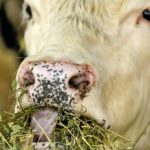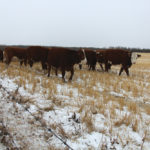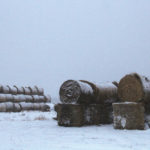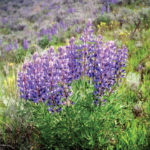
Tag Archives Hay

‘As fed’ or ‘dry matter’ — does it matter?
Nutrition with John McKinnon
When I visit with beef producers about their feeding program, I often sense confusion when I talk feed dry matter (DM) values or express intakes on a DM basis. Most producers, when they think of their feeding program, think “as fed” and have difficulty converting to DM. Getting this conversion correct, however, is critical to […] Read more

Consider more than cost during a winter feed shortage
Producers need to ruminate on logistics, pasture conditions and animal welfare, too
After a hot, dry summer in the Cypress Hills, Rick Toney knew some budgeting was in order to ensure his cows would be properly fed this winter. Toney, who ranches near Gull Lake, Sask., and serves as the chair of the Saskatchewan Cattlemen’s Association, runs around 500 cows in addition to a small backgrounding lot. […] Read more

Bale grazing. ‘What a waste of feed!’ NO
Grazing with Steve Kenyon
I still receive this comment quite often when I speak about bale grazing. Our industry is hung up on being efficient. We don’t want to waste anything. I know we have all been trained to target 97 per cent efficiency in everything we do. But I would rather be effective. Most of our efficiencies come from looking at […] Read more

Managing weather risks to feed and water
You can’t control the weather but you can increase your operation’s resilience
Drought is a fact of life for beef producers. And if it’s not too dry, there’s a good chance it’s wet enough to complicate haying operations. Producers can’t control the weather, but they can mitigate risks to water sources, pasture and feed. Extension specialists with Alberta Agriculture and Forestry share ideas on protecting those resources […] Read more

Beware of toxic plants in pastures
There are many toxic plants in Western Canada cattle producers need to steer clear of
Different regions have different problem plants, and to make it even more confusing these same plants are only toxic if eaten in certain amounts or in certain stages of growth, while others are toxic at all times. Rachel Turnquist, a forage extension specialist in Saskatchewan, says there are many toxic plants in Western Canada. You […] Read more

Strategies for year-round grazing
With careful forage management, cattle can harvest their own feed year-round
Winter feeding is the biggest input cost when raising cattle, so many producers try to minimize the number of days they have to feed hay. In some situations, with careful forage management, cattle can harvest their own feed year-round, especially in mild climates. Even in northern climates with cold weather and snow, year-round grazing can […] Read more

Protein kick needed for mature, dry forages
Nutrition: Supplementation will be important this year in many parts of the Prairies
In the fall and winter, most native forages and tame pastures are low in protein (unless fall rains have stimulated new growth), yet many stockmen try to extend grazing as long as possible through winter because winter feeding is the most expensive part of raising cattle. Depending on the protein source, adding a protein supplement […] Read more

Extending fall and winter grazing
Crop residues are probably the most underutilized source of winter grazing, says extension specialist
Extending the grazing season for cattle can help reduce production costs and there are various ways to increase forage production/utilization to ensure adequate fall grazing that can often be extended into winter. Lorne Klein, range management extension specialist, Ministry of Agriculture in Weyburn, Sask., says there are four sources of forage. “These are native prairie, […] Read more

Prairies’ dry weather may stem U.S. cattle stampede north
Winnipeg | Reuters — Parched pastures and crops in Western Canada are driving up cattle-feeding costs, and farmers and analysts expect the changing economics to stem a recent stampede of U.S. cattle being brought over the border. Canada imported 65,035 head of cattle from the U.S. from January through June, nearly double the pace of […] Read more

Livestock producers allowed to cut hay, graze on Manitoba Crown lands
Areas will be temporarily open to assist producers impacted by dry conditions
Livestock producers will temporarily be allowed to cut hay and allow animals to graze on Crown land not normally designated for agricultural use due to dry conditions across parts of the province, Manitoba Agriculture Minister Ralph Eichler announced today. “Pastures and forage crops in parts of Manitoba have been greatly affected by low levels of […] Read more



